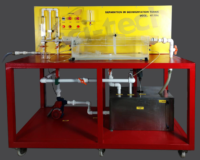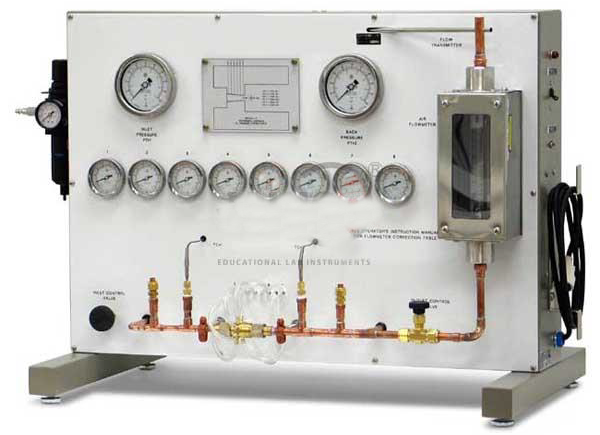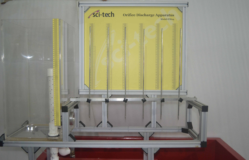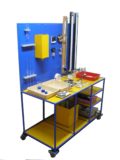Pressure Distribution Nozzles Performance Apparatus Model FM 51
Home » Products » Pressure Distribution Nozzles Performance Apparatus Model FM 51
Pressure Distribution Nozzles Performance Apparatus Model FM 51
Sci-tech Pressure Distribution Nozzle Performance Study Apparatus Model FM 51 is used to measure pressure curves in convergent and convergent-divergent nozzles (de Laval nozzles) and to study the actual flow of compressible fluids. In addition, the “choking effect” is demonstrated, where the mass flow rate stops increasing upon reaching the critical pressure ratio. Air is used as a compressible fluid.
In the experiment, the air flows through a nozzle and is thus accelerated. The pressure curve is recorded in the direction of flow over several measuring points. The air pressure upstream and downstream of the nozzle can be adjusted.
Three interchangeable nozzles are available to study the pressure and velocity ratios: one convergent contour and two de Laval nozzles with different length nozzle extensions.
The measured values for temperatures, pressures and mass flow rate are recorded.
The well-structured instructional material sets out the fundamentals and provides a step-by-step guide through the experiments.
Optional ‘Sci-Cal’ Computer Control Software & Interface in ‘LabVIEW’
| Size: | 80cm x 60cm x 60cm (LxWxH) |
| Weight: | 35 kg |
Item Description
Features
* Pressure distribution in convergent and divergent nozzles1
* Three nozzles with different contours1
* Speed of sound and shock wave
Convergent nozzles are used in the subsonic range. Velocities in the supersonic range can be achieved in de Laval nozzles; their nozzle geometry is a combination of convergent and divergent contours. De Laval nozzles are used in supersonic wind tunnels, steam turbines, jet engines and rocket technology. Pressure curves are a good way of representing the different velocity ranges in the nozzle, such as subsonic, supersonic and shock wave.
The experimental unit Sci-tech Pressure Distribution Nozzle Performance Study Apparatus Model FM 51 is used to measure pressure curves in convergent and convergent-divergent nozzles (de Laval nozzles) and to study the actual flow of compressible fluids. In addition, the “choking effect” is demonstrated, where the mass flow rate stops increasing upon reaching the critical pressure ratio. Air is used as a compressible fluid.
In the experiment, the air flows through a nozzle and is thus accelerated. The pressure curve is recorded in the direction of flow over several measuring points. The air pressure upstream and downstream of the nozzle can be adjusted.
Three interchangeable nozzles are available to study the pressure and velocity ratios: one convergent contour and two de Laval nozzles with different length nozzle extensions.
The measured values for temperatures, pressures and mass flow rate are recorded.
The well-structured instructional material sets out the fundamentals and provides a step-by-step guide through the experiments.
Optional ‘Sci-Cal’ Computer Control Software & Interface in ‘LabVIEW’
See also different:

Sci-tech Sedimentation Tank Model Demonstrator Model FM 66 is designed to investigate the factors influencing the separation process in sedimentation tanks. In sedimentation tanks, solids are separated out of suspensions under the influence of [...]



